Comparative Economic Analysis of Australia: Q1 2017 and Q2 2016
VerifiedAdded on 2019/10/30
|12
|2824
|301
Report
AI Summary
This report provides a comprehensive analysis of the present economic condition of Australia, focusing on a comparative study between the first quarter (Q1) of 2017 and the second quarter (Q2) of 2016. It utilizes key macroeconomic indicators such as GDP, unemployment rate, inflation rate, and balance of trade to assess the nation's economic health. The report highlights the impact of expansionary monetary policies implemented by the Reserve Bank of Australia (RBA) in stabilizing economic output and promoting growth. It also examines the influence of fiscal policies and interest rate adjustments on the market. Furthermore, the report discusses the importance of competition, innovation, and foreign direct investment (FDI) in fostering economic development and improving living standards. The analysis includes a comparison of GDP, unemployment, inflation, and trade balance between the two quarters, revealing trends and changes in the Australian economy. Finally, the report identifies potential challenges Australia may face in the next 12 months, including issues related to the tax system, an aging population, infrastructure, and capital investment.
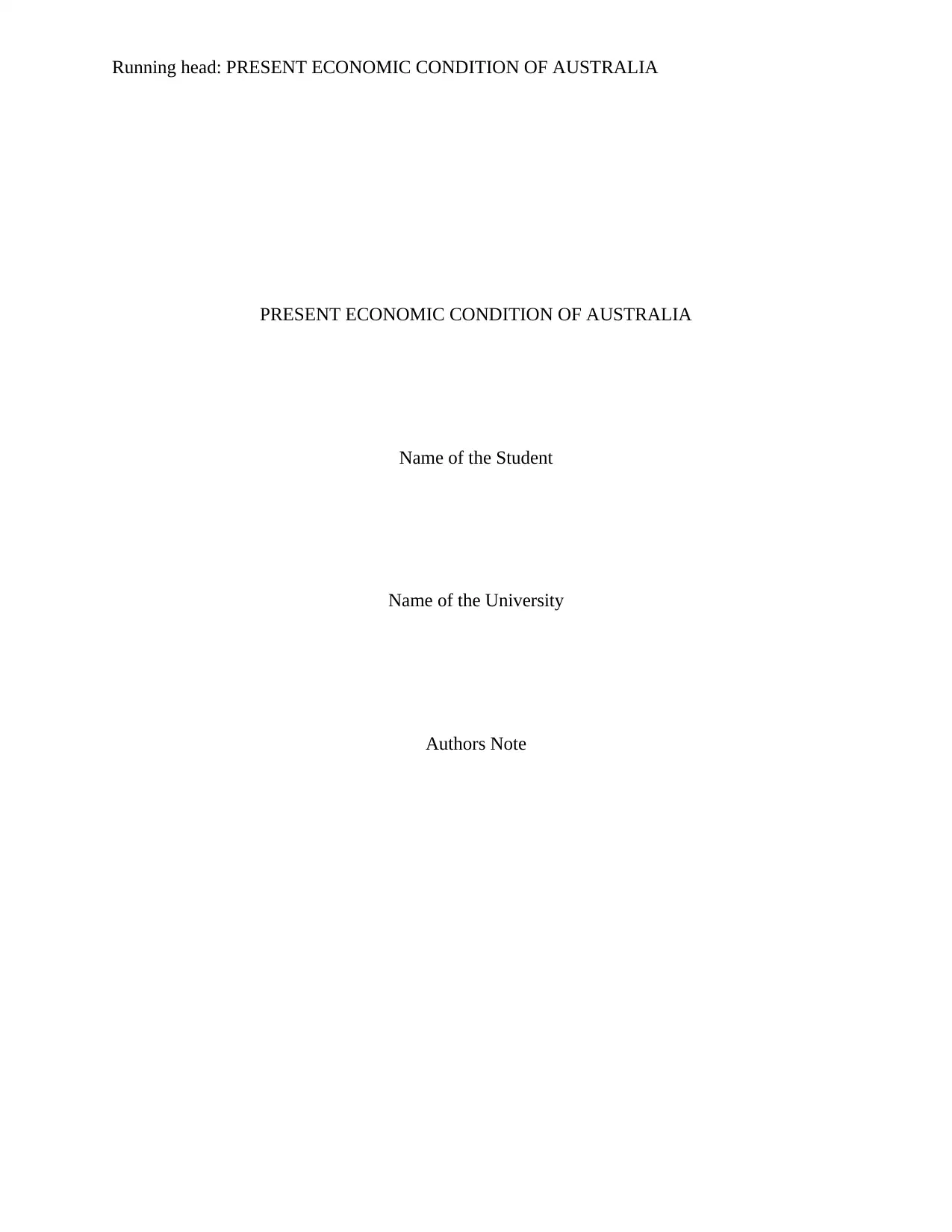
Running head: PRESENT ECONOMIC CONDITION OF AUSTRALIA
PRESENT ECONOMIC CONDITION OF AUSTRALIA
Name of the Student
Name of the University
Authors Note
PRESENT ECONOMIC CONDITION OF AUSTRALIA
Name of the Student
Name of the University
Authors Note
Paraphrase This Document
Need a fresh take? Get an instant paraphrase of this document with our AI Paraphraser
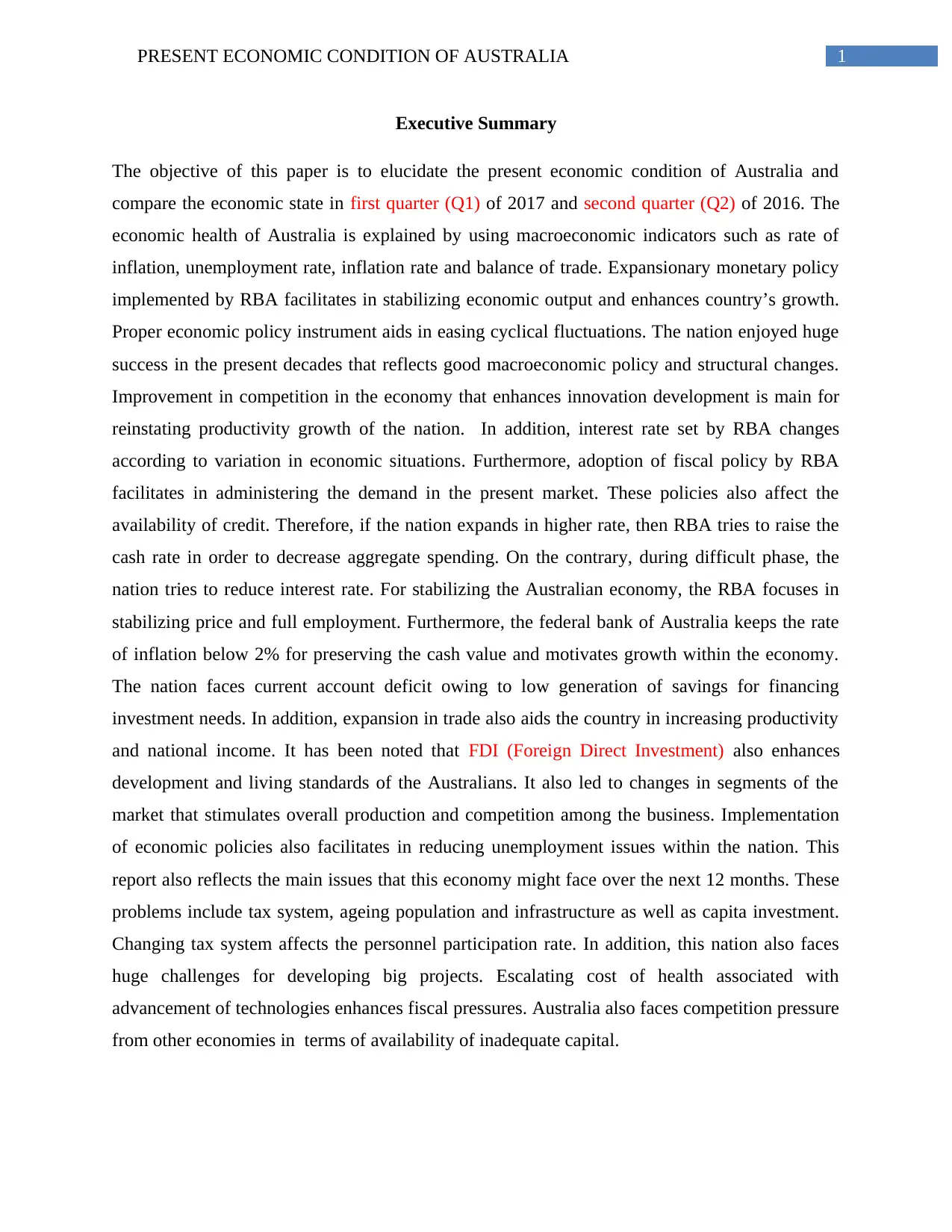
1PRESENT ECONOMIC CONDITION OF AUSTRALIA
Executive Summary
The objective of this paper is to elucidate the present economic condition of Australia and
compare the economic state in first quarter (Q1) of 2017 and second quarter (Q2) of 2016. The
economic health of Australia is explained by using macroeconomic indicators such as rate of
inflation, unemployment rate, inflation rate and balance of trade. Expansionary monetary policy
implemented by RBA facilitates in stabilizing economic output and enhances country’s growth.
Proper economic policy instrument aids in easing cyclical fluctuations. The nation enjoyed huge
success in the present decades that reflects good macroeconomic policy and structural changes.
Improvement in competition in the economy that enhances innovation development is main for
reinstating productivity growth of the nation. In addition, interest rate set by RBA changes
according to variation in economic situations. Furthermore, adoption of fiscal policy by RBA
facilitates in administering the demand in the present market. These policies also affect the
availability of credit. Therefore, if the nation expands in higher rate, then RBA tries to raise the
cash rate in order to decrease aggregate spending. On the contrary, during difficult phase, the
nation tries to reduce interest rate. For stabilizing the Australian economy, the RBA focuses in
stabilizing price and full employment. Furthermore, the federal bank of Australia keeps the rate
of inflation below 2% for preserving the cash value and motivates growth within the economy.
The nation faces current account deficit owing to low generation of savings for financing
investment needs. In addition, expansion in trade also aids the country in increasing productivity
and national income. It has been noted that FDI (Foreign Direct Investment) also enhances
development and living standards of the Australians. It also led to changes in segments of the
market that stimulates overall production and competition among the business. Implementation
of economic policies also facilitates in reducing unemployment issues within the nation. This
report also reflects the main issues that this economy might face over the next 12 months. These
problems include tax system, ageing population and infrastructure as well as capita investment.
Changing tax system affects the personnel participation rate. In addition, this nation also faces
huge challenges for developing big projects. Escalating cost of health associated with
advancement of technologies enhances fiscal pressures. Australia also faces competition pressure
from other economies in terms of availability of inadequate capital.
Executive Summary
The objective of this paper is to elucidate the present economic condition of Australia and
compare the economic state in first quarter (Q1) of 2017 and second quarter (Q2) of 2016. The
economic health of Australia is explained by using macroeconomic indicators such as rate of
inflation, unemployment rate, inflation rate and balance of trade. Expansionary monetary policy
implemented by RBA facilitates in stabilizing economic output and enhances country’s growth.
Proper economic policy instrument aids in easing cyclical fluctuations. The nation enjoyed huge
success in the present decades that reflects good macroeconomic policy and structural changes.
Improvement in competition in the economy that enhances innovation development is main for
reinstating productivity growth of the nation. In addition, interest rate set by RBA changes
according to variation in economic situations. Furthermore, adoption of fiscal policy by RBA
facilitates in administering the demand in the present market. These policies also affect the
availability of credit. Therefore, if the nation expands in higher rate, then RBA tries to raise the
cash rate in order to decrease aggregate spending. On the contrary, during difficult phase, the
nation tries to reduce interest rate. For stabilizing the Australian economy, the RBA focuses in
stabilizing price and full employment. Furthermore, the federal bank of Australia keeps the rate
of inflation below 2% for preserving the cash value and motivates growth within the economy.
The nation faces current account deficit owing to low generation of savings for financing
investment needs. In addition, expansion in trade also aids the country in increasing productivity
and national income. It has been noted that FDI (Foreign Direct Investment) also enhances
development and living standards of the Australians. It also led to changes in segments of the
market that stimulates overall production and competition among the business. Implementation
of economic policies also facilitates in reducing unemployment issues within the nation. This
report also reflects the main issues that this economy might face over the next 12 months. These
problems include tax system, ageing population and infrastructure as well as capita investment.
Changing tax system affects the personnel participation rate. In addition, this nation also faces
huge challenges for developing big projects. Escalating cost of health associated with
advancement of technologies enhances fiscal pressures. Australia also faces competition pressure
from other economies in terms of availability of inadequate capital.
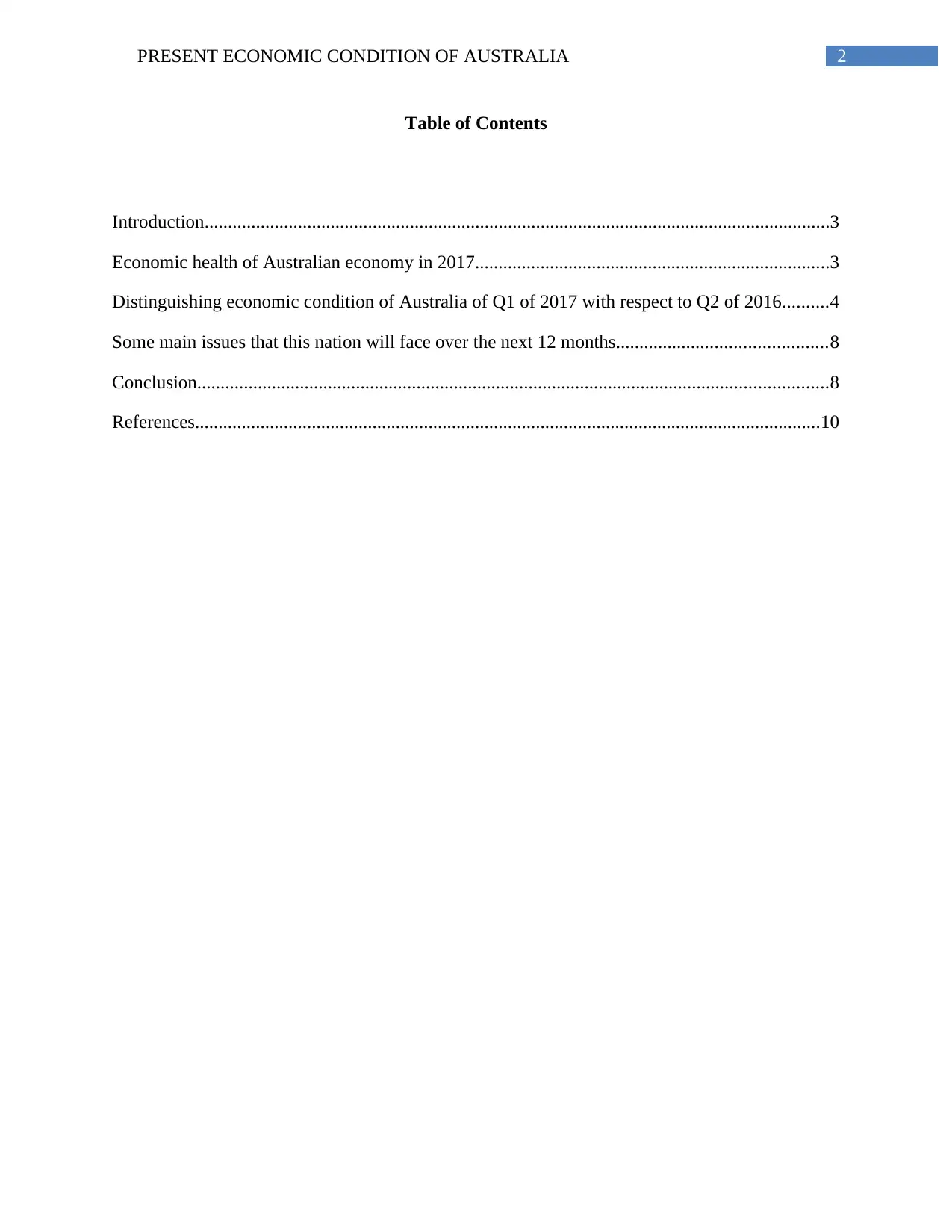
2PRESENT ECONOMIC CONDITION OF AUSTRALIA
Table of Contents
Introduction......................................................................................................................................3
Economic health of Australian economy in 2017............................................................................3
Distinguishing economic condition of Australia of Q1 of 2017 with respect to Q2 of 2016..........4
Some main issues that this nation will face over the next 12 months.............................................8
Conclusion.......................................................................................................................................8
References......................................................................................................................................10
Table of Contents
Introduction......................................................................................................................................3
Economic health of Australian economy in 2017............................................................................3
Distinguishing economic condition of Australia of Q1 of 2017 with respect to Q2 of 2016..........4
Some main issues that this nation will face over the next 12 months.............................................8
Conclusion.......................................................................................................................................8
References......................................................................................................................................10
⊘ This is a preview!⊘
Do you want full access?
Subscribe today to unlock all pages.

Trusted by 1+ million students worldwide
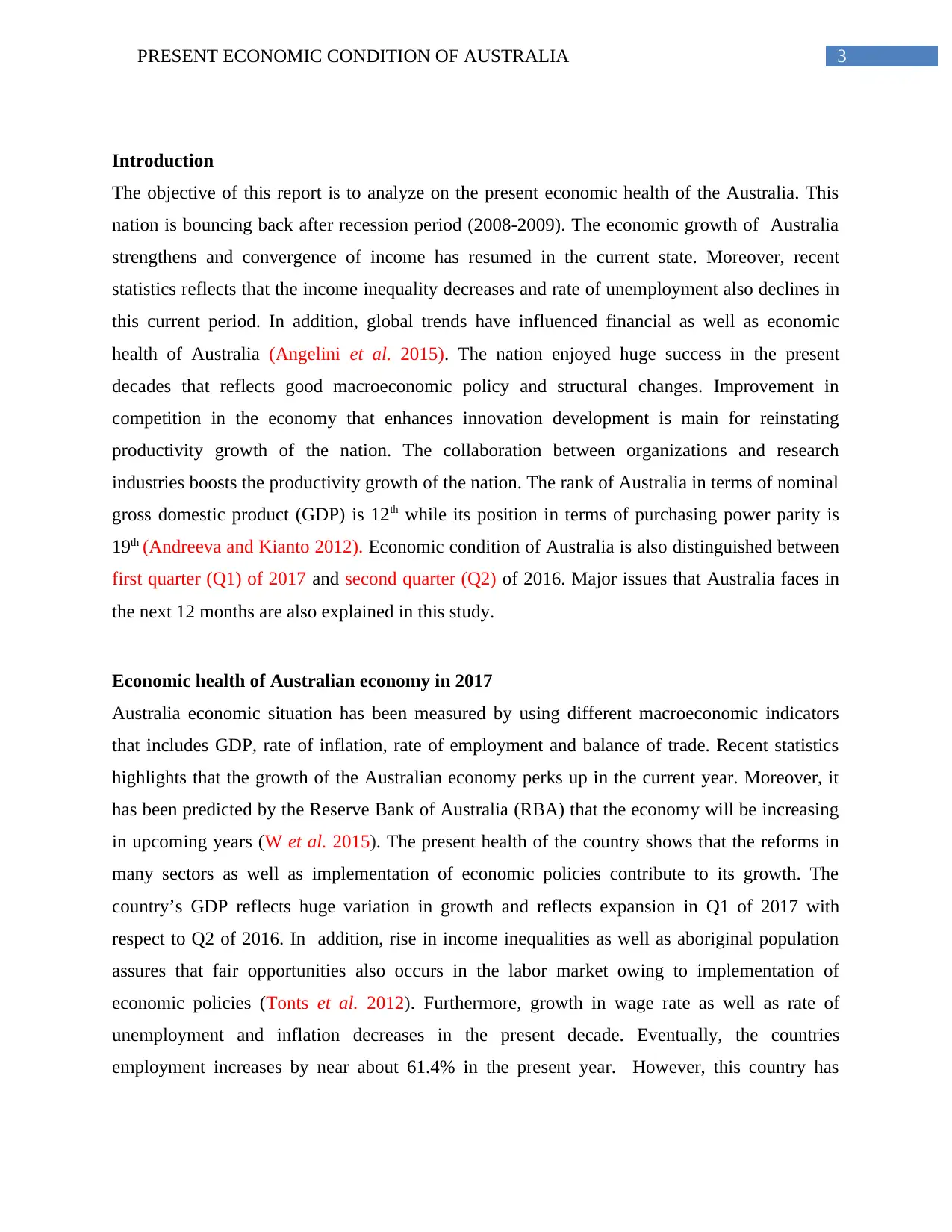
3PRESENT ECONOMIC CONDITION OF AUSTRALIA
Introduction
The objective of this report is to analyze on the present economic health of the Australia. This
nation is bouncing back after recession period (2008-2009). The economic growth of Australia
strengthens and convergence of income has resumed in the current state. Moreover, recent
statistics reflects that the income inequality decreases and rate of unemployment also declines in
this current period. In addition, global trends have influenced financial as well as economic
health of Australia (Angelini et al. 2015). The nation enjoyed huge success in the present
decades that reflects good macroeconomic policy and structural changes. Improvement in
competition in the economy that enhances innovation development is main for reinstating
productivity growth of the nation. The collaboration between organizations and research
industries boosts the productivity growth of the nation. The rank of Australia in terms of nominal
gross domestic product (GDP) is 12th while its position in terms of purchasing power parity is
19th (Andreeva and Kianto 2012). Economic condition of Australia is also distinguished between
first quarter (Q1) of 2017 and second quarter (Q2) of 2016. Major issues that Australia faces in
the next 12 months are also explained in this study.
Economic health of Australian economy in 2017
Australia economic situation has been measured by using different macroeconomic indicators
that includes GDP, rate of inflation, rate of employment and balance of trade. Recent statistics
highlights that the growth of the Australian economy perks up in the current year. Moreover, it
has been predicted by the Reserve Bank of Australia (RBA) that the economy will be increasing
in upcoming years (W et al. 2015). The present health of the country shows that the reforms in
many sectors as well as implementation of economic policies contribute to its growth. The
country’s GDP reflects huge variation in growth and reflects expansion in Q1 of 2017 with
respect to Q2 of 2016. In addition, rise in income inequalities as well as aboriginal population
assures that fair opportunities also occurs in the labor market owing to implementation of
economic policies (Tonts et al. 2012). Furthermore, growth in wage rate as well as rate of
unemployment and inflation decreases in the present decade. Eventually, the countries
employment increases by near about 61.4% in the present year. However, this country has
Introduction
The objective of this report is to analyze on the present economic health of the Australia. This
nation is bouncing back after recession period (2008-2009). The economic growth of Australia
strengthens and convergence of income has resumed in the current state. Moreover, recent
statistics reflects that the income inequality decreases and rate of unemployment also declines in
this current period. In addition, global trends have influenced financial as well as economic
health of Australia (Angelini et al. 2015). The nation enjoyed huge success in the present
decades that reflects good macroeconomic policy and structural changes. Improvement in
competition in the economy that enhances innovation development is main for reinstating
productivity growth of the nation. The collaboration between organizations and research
industries boosts the productivity growth of the nation. The rank of Australia in terms of nominal
gross domestic product (GDP) is 12th while its position in terms of purchasing power parity is
19th (Andreeva and Kianto 2012). Economic condition of Australia is also distinguished between
first quarter (Q1) of 2017 and second quarter (Q2) of 2016. Major issues that Australia faces in
the next 12 months are also explained in this study.
Economic health of Australian economy in 2017
Australia economic situation has been measured by using different macroeconomic indicators
that includes GDP, rate of inflation, rate of employment and balance of trade. Recent statistics
highlights that the growth of the Australian economy perks up in the current year. Moreover, it
has been predicted by the Reserve Bank of Australia (RBA) that the economy will be increasing
in upcoming years (W et al. 2015). The present health of the country shows that the reforms in
many sectors as well as implementation of economic policies contribute to its growth. The
country’s GDP reflects huge variation in growth and reflects expansion in Q1 of 2017 with
respect to Q2 of 2016. In addition, rise in income inequalities as well as aboriginal population
assures that fair opportunities also occurs in the labor market owing to implementation of
economic policies (Tonts et al. 2012). Furthermore, growth in wage rate as well as rate of
unemployment and inflation decreases in the present decade. Eventually, the countries
employment increases by near about 61.4% in the present year. However, this country has
Paraphrase This Document
Need a fresh take? Get an instant paraphrase of this document with our AI Paraphraser
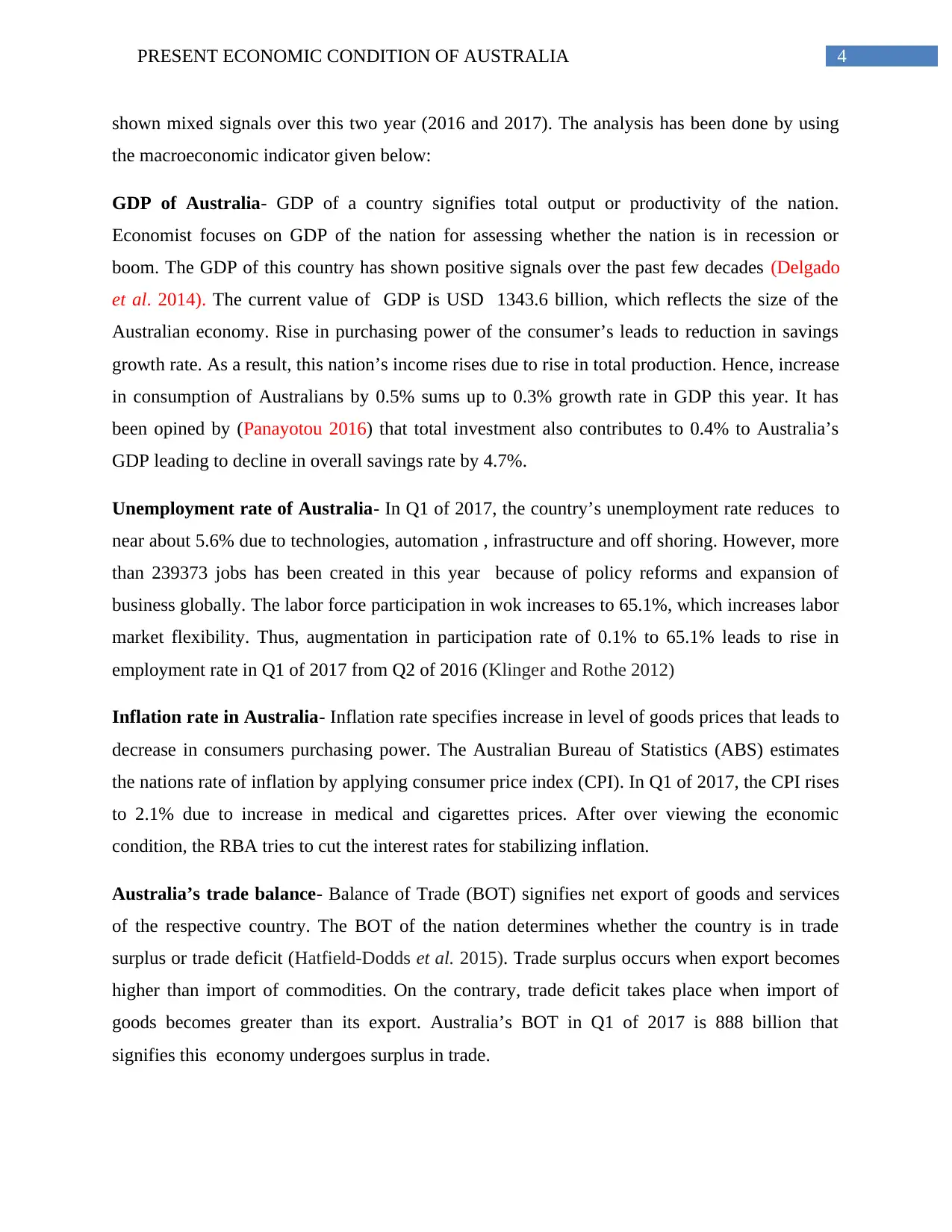
4PRESENT ECONOMIC CONDITION OF AUSTRALIA
shown mixed signals over this two year (2016 and 2017). The analysis has been done by using
the macroeconomic indicator given below:
GDP of Australia- GDP of a country signifies total output or productivity of the nation.
Economist focuses on GDP of the nation for assessing whether the nation is in recession or
boom. The GDP of this country has shown positive signals over the past few decades (Delgado
et al. 2014). The current value of GDP is USD 1343.6 billion, which reflects the size of the
Australian economy. Rise in purchasing power of the consumer’s leads to reduction in savings
growth rate. As a result, this nation’s income rises due to rise in total production. Hence, increase
in consumption of Australians by 0.5% sums up to 0.3% growth rate in GDP this year. It has
been opined by (Panayotou 2016) that total investment also contributes to 0.4% to Australia’s
GDP leading to decline in overall savings rate by 4.7%.
Unemployment rate of Australia- In Q1 of 2017, the country’s unemployment rate reduces to
near about 5.6% due to technologies, automation , infrastructure and off shoring. However, more
than 239373 jobs has been created in this year because of policy reforms and expansion of
business globally. The labor force participation in wok increases to 65.1%, which increases labor
market flexibility. Thus, augmentation in participation rate of 0.1% to 65.1% leads to rise in
employment rate in Q1 of 2017 from Q2 of 2016 (Klinger and Rothe 2012)
Inflation rate in Australia- Inflation rate specifies increase in level of goods prices that leads to
decrease in consumers purchasing power. The Australian Bureau of Statistics (ABS) estimates
the nations rate of inflation by applying consumer price index (CPI). In Q1 of 2017, the CPI rises
to 2.1% due to increase in medical and cigarettes prices. After over viewing the economic
condition, the RBA tries to cut the interest rates for stabilizing inflation.
Australia’s trade balance- Balance of Trade (BOT) signifies net export of goods and services
of the respective country. The BOT of the nation determines whether the country is in trade
surplus or trade deficit (Hatfield-Dodds et al. 2015). Trade surplus occurs when export becomes
higher than import of commodities. On the contrary, trade deficit takes place when import of
goods becomes greater than its export. Australia’s BOT in Q1 of 2017 is 888 billion that
signifies this economy undergoes surplus in trade.
shown mixed signals over this two year (2016 and 2017). The analysis has been done by using
the macroeconomic indicator given below:
GDP of Australia- GDP of a country signifies total output or productivity of the nation.
Economist focuses on GDP of the nation for assessing whether the nation is in recession or
boom. The GDP of this country has shown positive signals over the past few decades (Delgado
et al. 2014). The current value of GDP is USD 1343.6 billion, which reflects the size of the
Australian economy. Rise in purchasing power of the consumer’s leads to reduction in savings
growth rate. As a result, this nation’s income rises due to rise in total production. Hence, increase
in consumption of Australians by 0.5% sums up to 0.3% growth rate in GDP this year. It has
been opined by (Panayotou 2016) that total investment also contributes to 0.4% to Australia’s
GDP leading to decline in overall savings rate by 4.7%.
Unemployment rate of Australia- In Q1 of 2017, the country’s unemployment rate reduces to
near about 5.6% due to technologies, automation , infrastructure and off shoring. However, more
than 239373 jobs has been created in this year because of policy reforms and expansion of
business globally. The labor force participation in wok increases to 65.1%, which increases labor
market flexibility. Thus, augmentation in participation rate of 0.1% to 65.1% leads to rise in
employment rate in Q1 of 2017 from Q2 of 2016 (Klinger and Rothe 2012)
Inflation rate in Australia- Inflation rate specifies increase in level of goods prices that leads to
decrease in consumers purchasing power. The Australian Bureau of Statistics (ABS) estimates
the nations rate of inflation by applying consumer price index (CPI). In Q1 of 2017, the CPI rises
to 2.1% due to increase in medical and cigarettes prices. After over viewing the economic
condition, the RBA tries to cut the interest rates for stabilizing inflation.
Australia’s trade balance- Balance of Trade (BOT) signifies net export of goods and services
of the respective country. The BOT of the nation determines whether the country is in trade
surplus or trade deficit (Hatfield-Dodds et al. 2015). Trade surplus occurs when export becomes
higher than import of commodities. On the contrary, trade deficit takes place when import of
goods becomes greater than its export. Australia’s BOT in Q1 of 2017 is 888 billion that
signifies this economy undergoes surplus in trade.
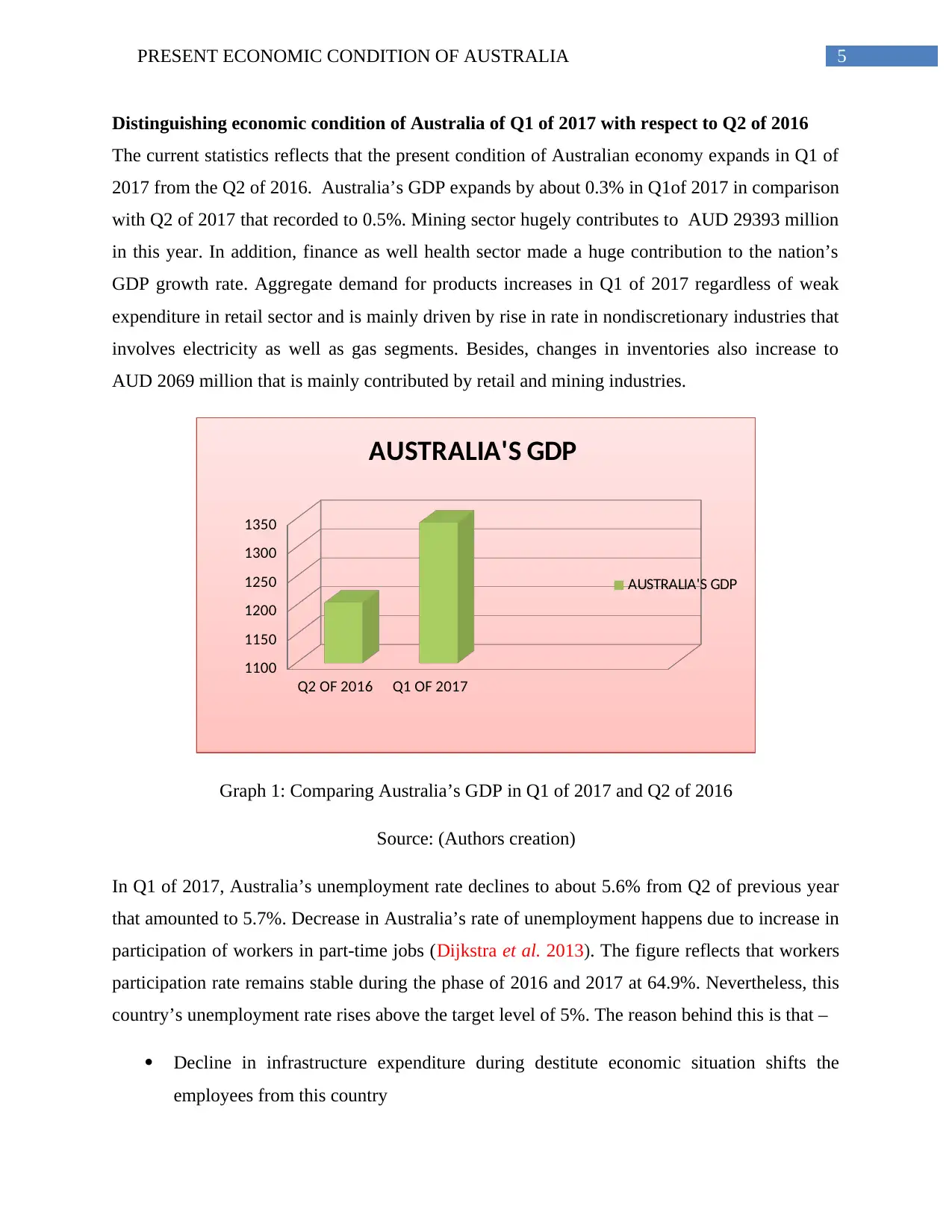
5PRESENT ECONOMIC CONDITION OF AUSTRALIA
Distinguishing economic condition of Australia of Q1 of 2017 with respect to Q2 of 2016
The current statistics reflects that the present condition of Australian economy expands in Q1 of
2017 from the Q2 of 2016. Australia’s GDP expands by about 0.3% in Q1of 2017 in comparison
with Q2 of 2017 that recorded to 0.5%. Mining sector hugely contributes to AUD 29393 million
in this year. In addition, finance as well health sector made a huge contribution to the nation’s
GDP growth rate. Aggregate demand for products increases in Q1 of 2017 regardless of weak
expenditure in retail sector and is mainly driven by rise in rate in nondiscretionary industries that
involves electricity as well as gas segments. Besides, changes in inventories also increase to
AUD 2069 million that is mainly contributed by retail and mining industries.
Q2 OF 2016 Q1 OF 2017
1100
1150
1200
1250
1300
1350
AUSTRALIA'S GDP
AUSTRALIA'S GDP
Graph 1: Comparing Australia’s GDP in Q1 of 2017 and Q2 of 2016
Source: (Authors creation)
In Q1 of 2017, Australia’s unemployment rate declines to about 5.6% from Q2 of previous year
that amounted to 5.7%. Decrease in Australia’s rate of unemployment happens due to increase in
participation of workers in part-time jobs (Dijkstra et al. 2013). The figure reflects that workers
participation rate remains stable during the phase of 2016 and 2017 at 64.9%. Nevertheless, this
country’s unemployment rate rises above the target level of 5%. The reason behind this is that –
Decline in infrastructure expenditure during destitute economic situation shifts the
employees from this country
Distinguishing economic condition of Australia of Q1 of 2017 with respect to Q2 of 2016
The current statistics reflects that the present condition of Australian economy expands in Q1 of
2017 from the Q2 of 2016. Australia’s GDP expands by about 0.3% in Q1of 2017 in comparison
with Q2 of 2017 that recorded to 0.5%. Mining sector hugely contributes to AUD 29393 million
in this year. In addition, finance as well health sector made a huge contribution to the nation’s
GDP growth rate. Aggregate demand for products increases in Q1 of 2017 regardless of weak
expenditure in retail sector and is mainly driven by rise in rate in nondiscretionary industries that
involves electricity as well as gas segments. Besides, changes in inventories also increase to
AUD 2069 million that is mainly contributed by retail and mining industries.
Q2 OF 2016 Q1 OF 2017
1100
1150
1200
1250
1300
1350
AUSTRALIA'S GDP
AUSTRALIA'S GDP
Graph 1: Comparing Australia’s GDP in Q1 of 2017 and Q2 of 2016
Source: (Authors creation)
In Q1 of 2017, Australia’s unemployment rate declines to about 5.6% from Q2 of previous year
that amounted to 5.7%. Decrease in Australia’s rate of unemployment happens due to increase in
participation of workers in part-time jobs (Dijkstra et al. 2013). The figure reflects that workers
participation rate remains stable during the phase of 2016 and 2017 at 64.9%. Nevertheless, this
country’s unemployment rate rises above the target level of 5%. The reason behind this is that –
Decline in infrastructure expenditure during destitute economic situation shifts the
employees from this country
⊘ This is a preview!⊘
Do you want full access?
Subscribe today to unlock all pages.

Trusted by 1+ million students worldwide
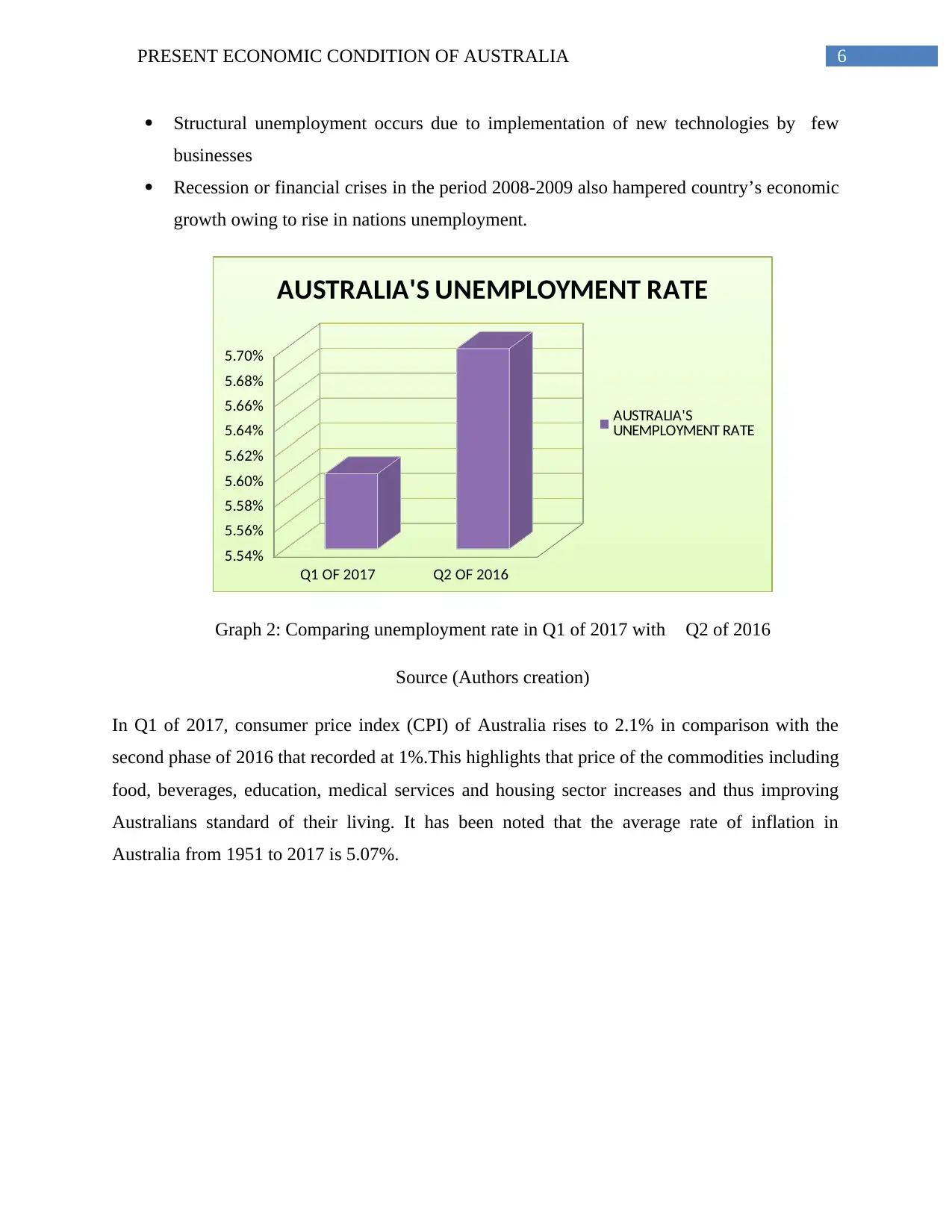
6PRESENT ECONOMIC CONDITION OF AUSTRALIA
Structural unemployment occurs due to implementation of new technologies by few
businesses
Recession or financial crises in the period 2008-2009 also hampered country’s economic
growth owing to rise in nations unemployment.
Q1 OF 2017 Q2 OF 2016
5.54%
5.56%
5.58%
5.60%
5.62%
5.64%
5.66%
5.68%
5.70%
AUSTRALIA'S UNEMPLOYMENT RATE
AUSTRALIA'S
UNEMPLOYMENT RATE
Graph 2: Comparing unemployment rate in Q1 of 2017 with Q2 of 2016
Source (Authors creation)
In Q1 of 2017, consumer price index (CPI) of Australia rises to 2.1% in comparison with the
second phase of 2016 that recorded at 1%.This highlights that price of the commodities including
food, beverages, education, medical services and housing sector increases and thus improving
Australians standard of their living. It has been noted that the average rate of inflation in
Australia from 1951 to 2017 is 5.07%.
Structural unemployment occurs due to implementation of new technologies by few
businesses
Recession or financial crises in the period 2008-2009 also hampered country’s economic
growth owing to rise in nations unemployment.
Q1 OF 2017 Q2 OF 2016
5.54%
5.56%
5.58%
5.60%
5.62%
5.64%
5.66%
5.68%
5.70%
AUSTRALIA'S UNEMPLOYMENT RATE
AUSTRALIA'S
UNEMPLOYMENT RATE
Graph 2: Comparing unemployment rate in Q1 of 2017 with Q2 of 2016
Source (Authors creation)
In Q1 of 2017, consumer price index (CPI) of Australia rises to 2.1% in comparison with the
second phase of 2016 that recorded at 1%.This highlights that price of the commodities including
food, beverages, education, medical services and housing sector increases and thus improving
Australians standard of their living. It has been noted that the average rate of inflation in
Australia from 1951 to 2017 is 5.07%.
Paraphrase This Document
Need a fresh take? Get an instant paraphrase of this document with our AI Paraphraser
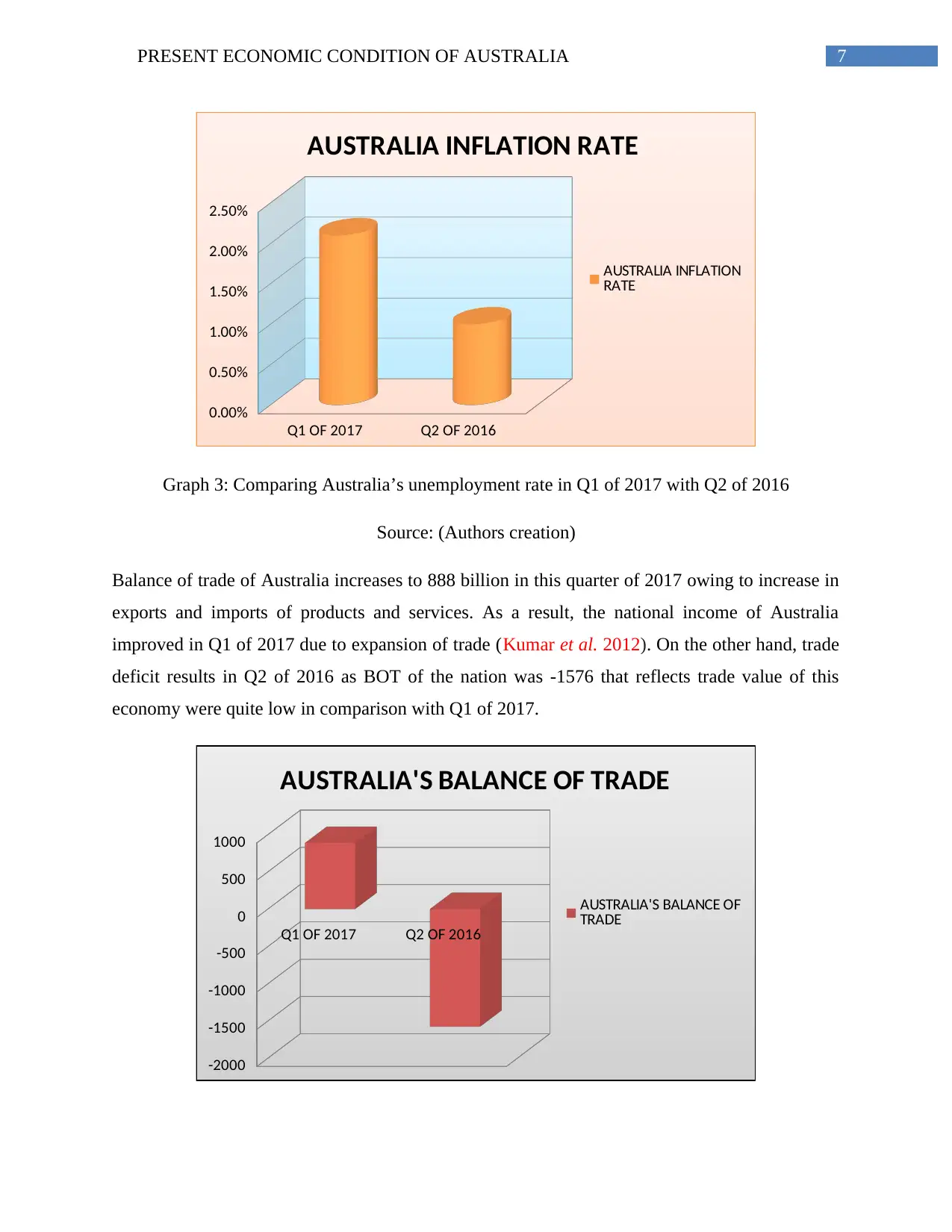
7PRESENT ECONOMIC CONDITION OF AUSTRALIA
Q1 OF 2017 Q2 OF 2016
0.00%
0.50%
1.00%
1.50%
2.00%
2.50%
AUSTRALIA INFLATION RATE
AUSTRALIA INFLATION
RATE
Graph 3: Comparing Australia’s unemployment rate in Q1 of 2017 with Q2 of 2016
Source: (Authors creation)
Balance of trade of Australia increases to 888 billion in this quarter of 2017 owing to increase in
exports and imports of products and services. As a result, the national income of Australia
improved in Q1 of 2017 due to expansion of trade (Kumar et al. 2012). On the other hand, trade
deficit results in Q2 of 2016 as BOT of the nation was -1576 that reflects trade value of this
economy were quite low in comparison with Q1 of 2017.
Q1 OF 2017 Q2 OF 2016
-2000
-1500
-1000
-500
0
500
1000
AUSTRALIA'S BALANCE OF TRADE
AUSTRALIA'S BALANCE OF
TRADE
Q1 OF 2017 Q2 OF 2016
0.00%
0.50%
1.00%
1.50%
2.00%
2.50%
AUSTRALIA INFLATION RATE
AUSTRALIA INFLATION
RATE
Graph 3: Comparing Australia’s unemployment rate in Q1 of 2017 with Q2 of 2016
Source: (Authors creation)
Balance of trade of Australia increases to 888 billion in this quarter of 2017 owing to increase in
exports and imports of products and services. As a result, the national income of Australia
improved in Q1 of 2017 due to expansion of trade (Kumar et al. 2012). On the other hand, trade
deficit results in Q2 of 2016 as BOT of the nation was -1576 that reflects trade value of this
economy were quite low in comparison with Q1 of 2017.
Q1 OF 2017 Q2 OF 2016
-2000
-1500
-1000
-500
0
500
1000
AUSTRALIA'S BALANCE OF TRADE
AUSTRALIA'S BALANCE OF
TRADE
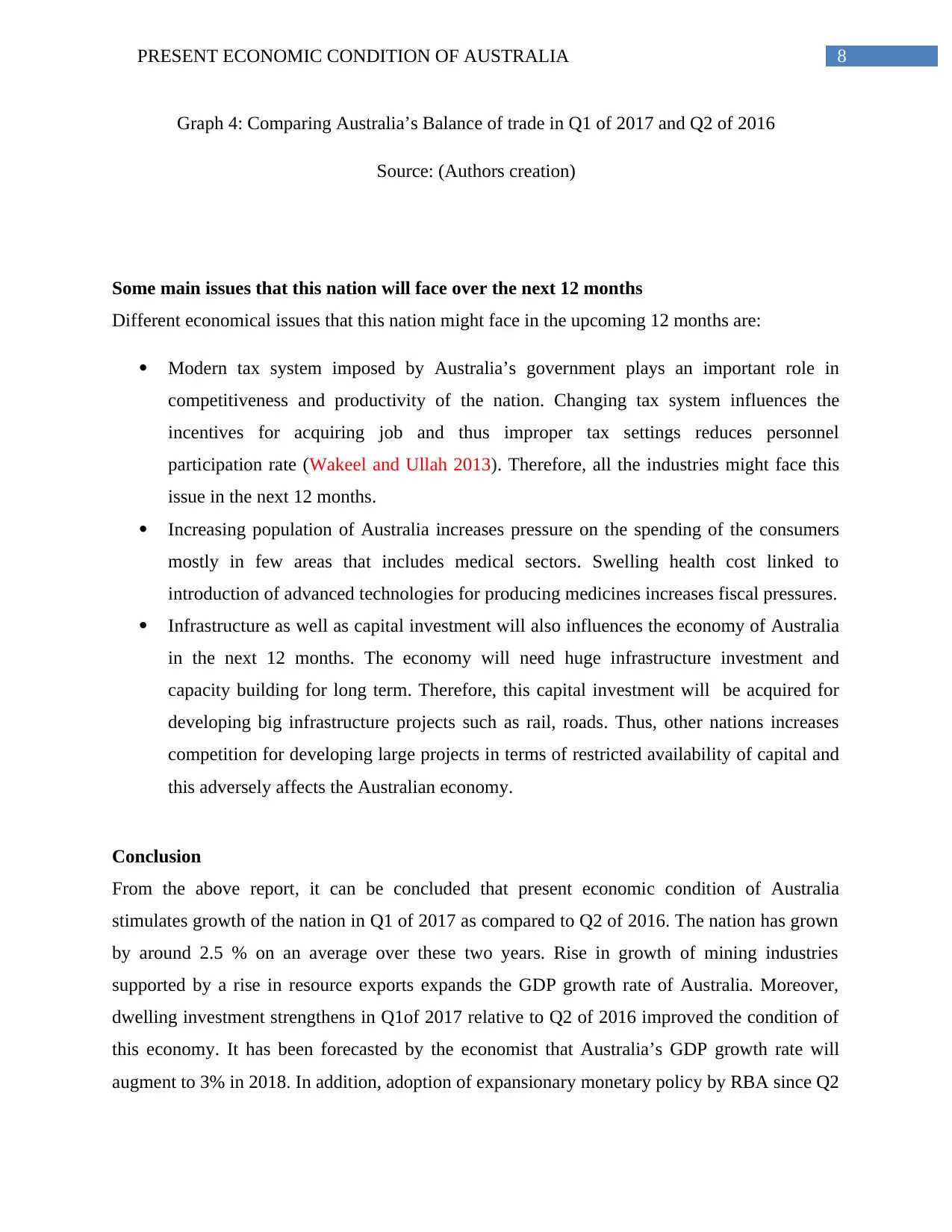
8PRESENT ECONOMIC CONDITION OF AUSTRALIA
Graph 4: Comparing Australia’s Balance of trade in Q1 of 2017 and Q2 of 2016
Source: (Authors creation)
Some main issues that this nation will face over the next 12 months
Different economical issues that this nation might face in the upcoming 12 months are:
Modern tax system imposed by Australia’s government plays an important role in
competitiveness and productivity of the nation. Changing tax system influences the
incentives for acquiring job and thus improper tax settings reduces personnel
participation rate (Wakeel and Ullah 2013). Therefore, all the industries might face this
issue in the next 12 months.
Increasing population of Australia increases pressure on the spending of the consumers
mostly in few areas that includes medical sectors. Swelling health cost linked to
introduction of advanced technologies for producing medicines increases fiscal pressures.
Infrastructure as well as capital investment will also influences the economy of Australia
in the next 12 months. The economy will need huge infrastructure investment and
capacity building for long term. Therefore, this capital investment will be acquired for
developing big infrastructure projects such as rail, roads. Thus, other nations increases
competition for developing large projects in terms of restricted availability of capital and
this adversely affects the Australian economy.
Conclusion
From the above report, it can be concluded that present economic condition of Australia
stimulates growth of the nation in Q1 of 2017 as compared to Q2 of 2016. The nation has grown
by around 2.5 % on an average over these two years. Rise in growth of mining industries
supported by a rise in resource exports expands the GDP growth rate of Australia. Moreover,
dwelling investment strengthens in Q1of 2017 relative to Q2 of 2016 improved the condition of
this economy. It has been forecasted by the economist that Australia’s GDP growth rate will
augment to 3% in 2018. In addition, adoption of expansionary monetary policy by RBA since Q2
Graph 4: Comparing Australia’s Balance of trade in Q1 of 2017 and Q2 of 2016
Source: (Authors creation)
Some main issues that this nation will face over the next 12 months
Different economical issues that this nation might face in the upcoming 12 months are:
Modern tax system imposed by Australia’s government plays an important role in
competitiveness and productivity of the nation. Changing tax system influences the
incentives for acquiring job and thus improper tax settings reduces personnel
participation rate (Wakeel and Ullah 2013). Therefore, all the industries might face this
issue in the next 12 months.
Increasing population of Australia increases pressure on the spending of the consumers
mostly in few areas that includes medical sectors. Swelling health cost linked to
introduction of advanced technologies for producing medicines increases fiscal pressures.
Infrastructure as well as capital investment will also influences the economy of Australia
in the next 12 months. The economy will need huge infrastructure investment and
capacity building for long term. Therefore, this capital investment will be acquired for
developing big infrastructure projects such as rail, roads. Thus, other nations increases
competition for developing large projects in terms of restricted availability of capital and
this adversely affects the Australian economy.
Conclusion
From the above report, it can be concluded that present economic condition of Australia
stimulates growth of the nation in Q1 of 2017 as compared to Q2 of 2016. The nation has grown
by around 2.5 % on an average over these two years. Rise in growth of mining industries
supported by a rise in resource exports expands the GDP growth rate of Australia. Moreover,
dwelling investment strengthens in Q1of 2017 relative to Q2 of 2016 improved the condition of
this economy. It has been forecasted by the economist that Australia’s GDP growth rate will
augment to 3% in 2018. In addition, adoption of expansionary monetary policy by RBA since Q2
⊘ This is a preview!⊘
Do you want full access?
Subscribe today to unlock all pages.

Trusted by 1+ million students worldwide
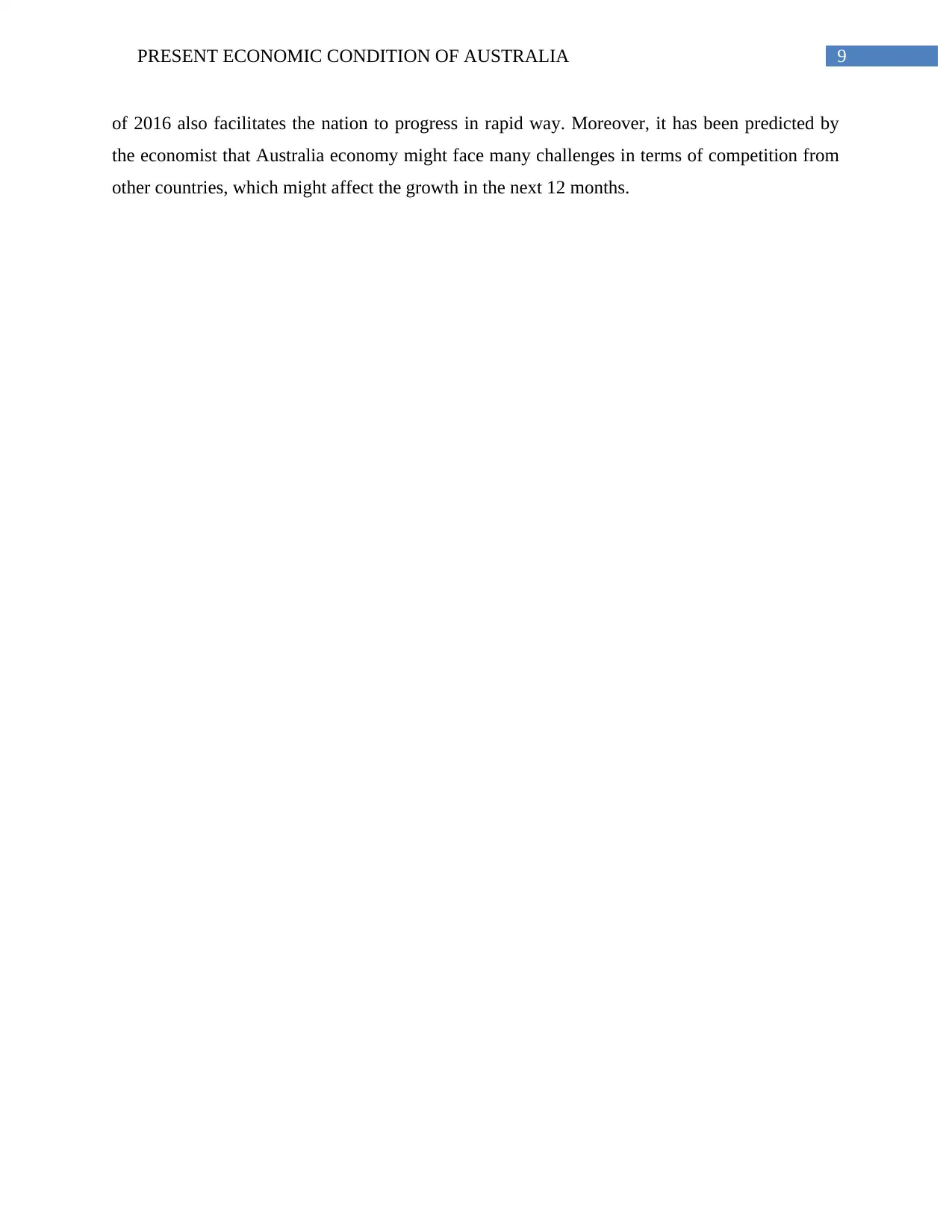
9PRESENT ECONOMIC CONDITION OF AUSTRALIA
of 2016 also facilitates the nation to progress in rapid way. Moreover, it has been predicted by
the economist that Australia economy might face many challenges in terms of competition from
other countries, which might affect the growth in the next 12 months.
of 2016 also facilitates the nation to progress in rapid way. Moreover, it has been predicted by
the economist that Australia economy might face many challenges in terms of competition from
other countries, which might affect the growth in the next 12 months.
Paraphrase This Document
Need a fresh take? Get an instant paraphrase of this document with our AI Paraphraser
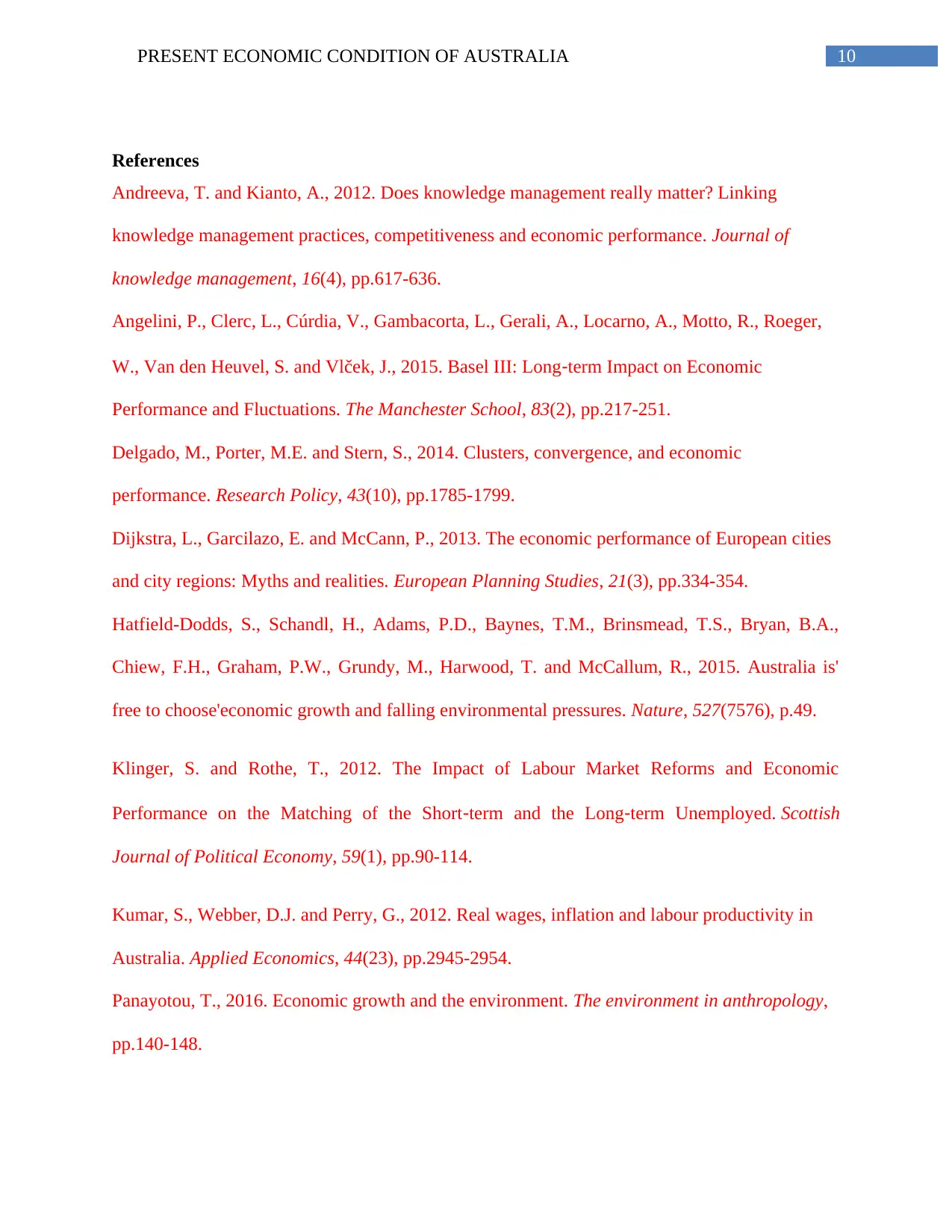
10PRESENT ECONOMIC CONDITION OF AUSTRALIA
References
Andreeva, T. and Kianto, A., 2012. Does knowledge management really matter? Linking
knowledge management practices, competitiveness and economic performance. Journal of
knowledge management, 16(4), pp.617-636.
Angelini, P., Clerc, L., Cúrdia, V., Gambacorta, L., Gerali, A., Locarno, A., Motto, R., Roeger,
W., Van den Heuvel, S. and Vlček, J., 2015. Basel III: Long‐term Impact on Economic
Performance and Fluctuations. The Manchester School, 83(2), pp.217-251.
Delgado, M., Porter, M.E. and Stern, S., 2014. Clusters, convergence, and economic
performance. Research Policy, 43(10), pp.1785-1799.
Dijkstra, L., Garcilazo, E. and McCann, P., 2013. The economic performance of European cities
and city regions: Myths and realities. European Planning Studies, 21(3), pp.334-354.
Hatfield-Dodds, S., Schandl, H., Adams, P.D., Baynes, T.M., Brinsmead, T.S., Bryan, B.A.,
Chiew, F.H., Graham, P.W., Grundy, M., Harwood, T. and McCallum, R., 2015. Australia is'
free to choose'economic growth and falling environmental pressures. Nature, 527(7576), p.49.
Klinger, S. and Rothe, T., 2012. The Impact of Labour Market Reforms and Economic
Performance on the Matching of the Short‐term and the Long‐term Unemployed. Scottish
Journal of Political Economy, 59(1), pp.90-114.
Kumar, S., Webber, D.J. and Perry, G., 2012. Real wages, inflation and labour productivity in
Australia. Applied Economics, 44(23), pp.2945-2954.
Panayotou, T., 2016. Economic growth and the environment. The environment in anthropology,
pp.140-148.
References
Andreeva, T. and Kianto, A., 2012. Does knowledge management really matter? Linking
knowledge management practices, competitiveness and economic performance. Journal of
knowledge management, 16(4), pp.617-636.
Angelini, P., Clerc, L., Cúrdia, V., Gambacorta, L., Gerali, A., Locarno, A., Motto, R., Roeger,
W., Van den Heuvel, S. and Vlček, J., 2015. Basel III: Long‐term Impact on Economic
Performance and Fluctuations. The Manchester School, 83(2), pp.217-251.
Delgado, M., Porter, M.E. and Stern, S., 2014. Clusters, convergence, and economic
performance. Research Policy, 43(10), pp.1785-1799.
Dijkstra, L., Garcilazo, E. and McCann, P., 2013. The economic performance of European cities
and city regions: Myths and realities. European Planning Studies, 21(3), pp.334-354.
Hatfield-Dodds, S., Schandl, H., Adams, P.D., Baynes, T.M., Brinsmead, T.S., Bryan, B.A.,
Chiew, F.H., Graham, P.W., Grundy, M., Harwood, T. and McCallum, R., 2015. Australia is'
free to choose'economic growth and falling environmental pressures. Nature, 527(7576), p.49.
Klinger, S. and Rothe, T., 2012. The Impact of Labour Market Reforms and Economic
Performance on the Matching of the Short‐term and the Long‐term Unemployed. Scottish
Journal of Political Economy, 59(1), pp.90-114.
Kumar, S., Webber, D.J. and Perry, G., 2012. Real wages, inflation and labour productivity in
Australia. Applied Economics, 44(23), pp.2945-2954.
Panayotou, T., 2016. Economic growth and the environment. The environment in anthropology,
pp.140-148.
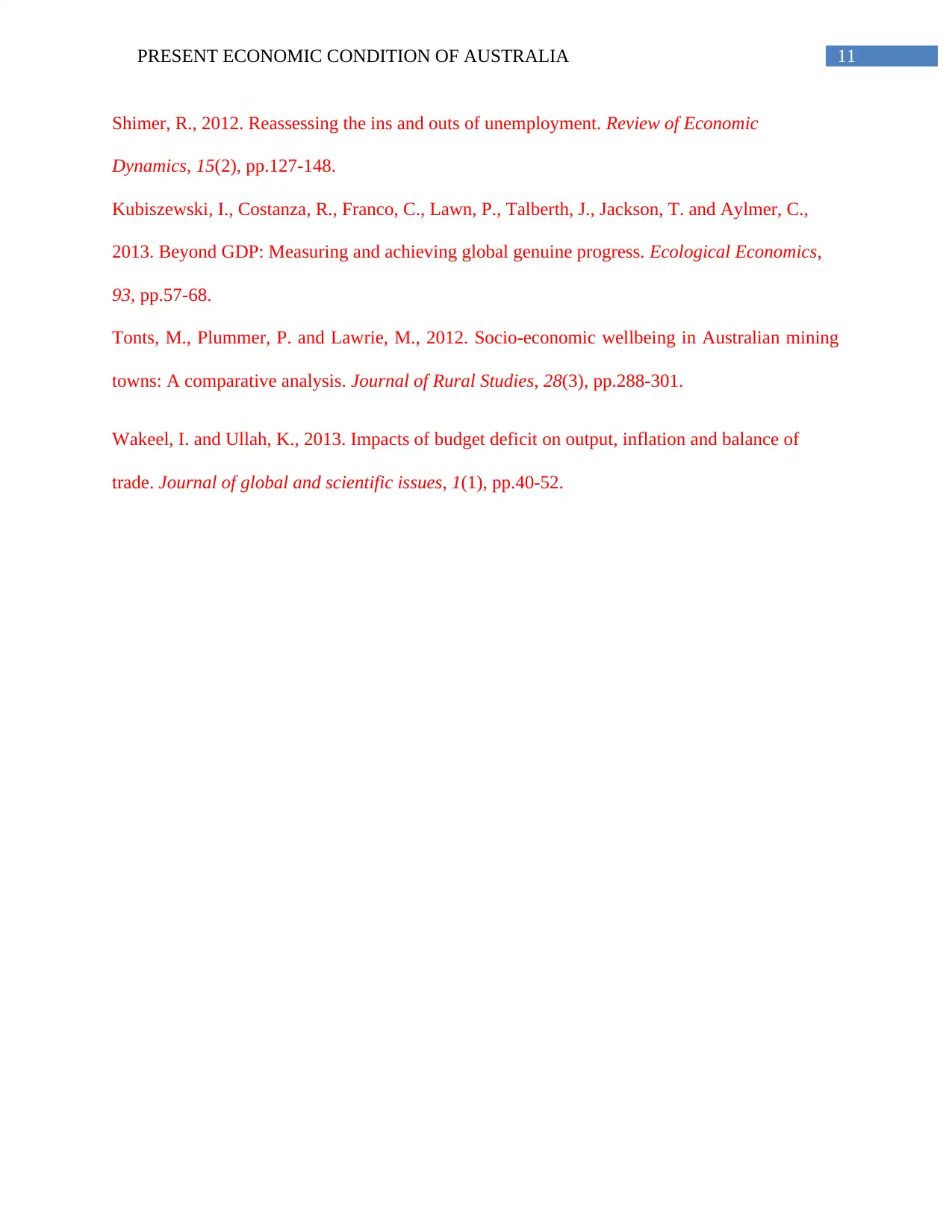
11PRESENT ECONOMIC CONDITION OF AUSTRALIA
Shimer, R., 2012. Reassessing the ins and outs of unemployment. Review of Economic
Dynamics, 15(2), pp.127-148.
Kubiszewski, I., Costanza, R., Franco, C., Lawn, P., Talberth, J., Jackson, T. and Aylmer, C.,
2013. Beyond GDP: Measuring and achieving global genuine progress. Ecological Economics,
93, pp.57-68.
Tonts, M., Plummer, P. and Lawrie, M., 2012. Socio-economic wellbeing in Australian mining
towns: A comparative analysis. Journal of Rural Studies, 28(3), pp.288-301.
Wakeel, I. and Ullah, K., 2013. Impacts of budget deficit on output, inflation and balance of
trade. Journal of global and scientific issues, 1(1), pp.40-52.
Shimer, R., 2012. Reassessing the ins and outs of unemployment. Review of Economic
Dynamics, 15(2), pp.127-148.
Kubiszewski, I., Costanza, R., Franco, C., Lawn, P., Talberth, J., Jackson, T. and Aylmer, C.,
2013. Beyond GDP: Measuring and achieving global genuine progress. Ecological Economics,
93, pp.57-68.
Tonts, M., Plummer, P. and Lawrie, M., 2012. Socio-economic wellbeing in Australian mining
towns: A comparative analysis. Journal of Rural Studies, 28(3), pp.288-301.
Wakeel, I. and Ullah, K., 2013. Impacts of budget deficit on output, inflation and balance of
trade. Journal of global and scientific issues, 1(1), pp.40-52.
⊘ This is a preview!⊘
Do you want full access?
Subscribe today to unlock all pages.

Trusted by 1+ million students worldwide
1 out of 12
Related Documents
Your All-in-One AI-Powered Toolkit for Academic Success.
+13062052269
info@desklib.com
Available 24*7 on WhatsApp / Email
![[object Object]](/_next/static/media/star-bottom.7253800d.svg)
Unlock your academic potential
Copyright © 2020–2025 A2Z Services. All Rights Reserved. Developed and managed by ZUCOL.



